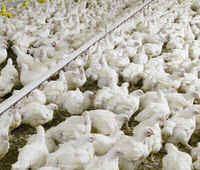



Profound impact of nutrition on broiler profitability
US - Broiler growers naturally strive to achieve top returns, but the route to success can be very different from breed to breed.
Profound impact of nutrition on broiler profitability - US - Broiler growers naturally strive to achieve top returns, but the route to success can be very different from breed to breed.

This is certainly not, however, the approach we recommend with the Cobb 500 broiler. Profitable and healthy growth does not depend on exceptionally high protein levels in the first three weeks, even allowing many growers to take advantage of reduced feed costs while still attaining satisfactory body weight targets.
Our recommendations are based on 21 % protein in the starter ration, 19 % in the grower, reducing to 18 and then 17 % for finishing. These protein levels are 2 to 4 % lower than many growers are currently using.
You might think that feeding the birds extra protein is benefiting them. The simple fact is that the Cobb 500 does not need the extra growth which this protein can bring - and this could risk the health of the birds as well as adding unnecessarily to the feed cost.
Using lower protein and lower nutrient density feeds for the first 21 days can save growers around £6 per tonne over the growing cycle. Furthermore, using whole grain wheat up to 20% in the finisher with a balancer to provide the right level of essential nutrients can save another £5.50 or so.
Growers are often tempted to aim for a performance which slightly exceeds the growth charts provided by the breeding companies. We do not believe this is good policy and the best growers will seek to follow, but not exceed, the growth targets during the first few weeks.
Research has shown that controlling early growth by using feeds of lower nutrient density can improve bone development, particularly in these critical first three weeks. With the right nutrient density during the later growth periods, the birds will also achieve improved feed conversion over the whole production period.
Feed form also has an important influence on growth. High wheat content in the diet helps contribute to the durable quality of pelleted feed and also the crumbs normally provided to chicks for the first eight to ten days.
The pelleting process denatures some of the protein, making particular amino acids more freely available than normal. The birds find pellets quicker and easier to eat, reducing the activity level compared to meal which has to be retrieved from the litter as well as the feed track or pan.
To take advantage of the potential feed saving in using lower protein diets, you can obtain further details from Cobb's UK office (01245 400109) or e-mail [email protected]
Source: Dr John Halley, Director of Nutrition, Cobb World Technical Support Team, Cobb - 21st December 2005

Genetic differences between the most widely used breeds mean that no single management approach is appropriate for all broilers. Indeed, there are aspects where what might be sound advice for one breed can be detrimental to another.
Nutrition plays a central role in broiler growing and it is here that even small changes can have such a profound impact on profitability. Much attention recently has focused on nutrient density and protein levels during the early weeks, often suggesting that more protein will mean better performance and profitability.
 Dr John Halley |
Our recommendations are based on 21 % protein in the starter ration, 19 % in the grower, reducing to 18 and then 17 % for finishing. These protein levels are 2 to 4 % lower than many growers are currently using.
You might think that feeding the birds extra protein is benefiting them. The simple fact is that the Cobb 500 does not need the extra growth which this protein can bring - and this could risk the health of the birds as well as adding unnecessarily to the feed cost.
Using lower protein and lower nutrient density feeds for the first 21 days can save growers around £6 per tonne over the growing cycle. Furthermore, using whole grain wheat up to 20% in the finisher with a balancer to provide the right level of essential nutrients can save another £5.50 or so.
 |
Research has shown that controlling early growth by using feeds of lower nutrient density can improve bone development, particularly in these critical first three weeks. With the right nutrient density during the later growth periods, the birds will also achieve improved feed conversion over the whole production period.
Feed form also has an important influence on growth. High wheat content in the diet helps contribute to the durable quality of pelleted feed and also the crumbs normally provided to chicks for the first eight to ten days.
The pelleting process denatures some of the protein, making particular amino acids more freely available than normal. The birds find pellets quicker and easier to eat, reducing the activity level compared to meal which has to be retrieved from the litter as well as the feed track or pan.
To take advantage of the potential feed saving in using lower protein diets, you can obtain further details from Cobb's UK office (01245 400109) or e-mail [email protected]
Source: Dr John Halley, Director of Nutrition, Cobb World Technical Support Team, Cobb - 21st December 2005











